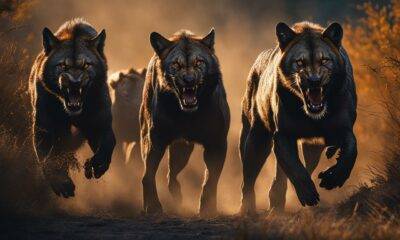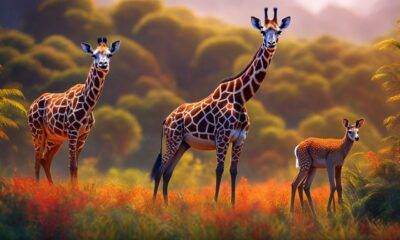All Animals
ALL about Lagomorphs Explained!

Welcome to our comprehensive guide on lagomorphs! If you’re curious about ALL about Lagomorphs, you’ve come to the right place. Lagomorphs are a diverse group of mammals that include rabbits, hares, and pikas. They have fascinating characteristics, behavior, and adaptations that make them stand out in the animal kingdom. In this article, we will delve into the facts about lagomorphs and explore the different species that belong to this order.
Lagomorphs are known for their distinct features, such as their long ears, short tails, and strong hind limbs. They are primarily herbivores and possess a unique digestive system that allows them to extract maximum nutrition from their diet. With 87 species in total, including some endangered ones, there’s so much to learn about these fascinating creatures.
Key Takeaways:
- Lagomorphs are a group of mammals that belong to the order Lagomorpha.
- They include rabbits, hares, and pikas, and are primarily herbivores.
- Lagomorphs have unique characteristics like long ears, short tails, and strong hind limbs.
- There are 87 species of lagomorphs, with some species being endangered.
- Stay tuned as we explore lagomorphs characteristics, behavior, habitat, diet, reproduction, conservation, and fun facts!
Lagomorphs Characteristics and Behavior
Lagomorphs, including rabbits, hares, and pikas, possess unique characteristics and exhibit fascinating behaviors that set them apart from other mammals. These small to medium-sized herbivores feature continuously growing incisors and a second pair of peglike incisors in their upper jaw, enabling them to efficiently bite off and shred plant tissues. Additionally, lagomorphs produce two types of feces – solid round droppings and soft black greaselike pellets – aiding in efficient digestion.
One intriguing aspect of lagomorph behavior is coprophagy, where they consume their softer feces to reingest nutrients missed during the initial digestion process. While lagomorph mothers are known to be inattentive to their young, visiting them only once a day for a short duration, their milk is highly nutritious, allowing the young to grow rapidly. Despite their seemingly distant parenting style, lagomorphs play a vital role in many terrestrial communities as prey species, contributing to the balance of ecosystems.
| Lagomorph Characteristics | Lagomorph Behavior |
|---|---|
| Long ears | Efficiently bite off and shred plant tissues |
| Short tails | Produce two types of feces: solid round droppings and soft black greaselike pellets |
| Strong hind limbs | Engage in coprophagy to reingest missed nutrients |
| Continuously growing incisors | Inattentive parenting style |
| Second pair of peglike incisors | Highly nutritious milk for rapid young growth |
Understanding the characteristics and behavior of lagomorphs provides valuable insights into their adaptation mechanisms and ecological significance within their respective habitats.
Lagomorphs Habitat and Distribution
Lagomorphs, including rabbits, hares, and pikas, are found in various habitats across the world, except Antarctica. They have adapted to thrive in diverse environments, from grasslands to arid regions and mountainous areas.
Rabbits and hares have a wider distribution compared to pikas, which are mainly found in the mountains of western North America and Asia. Pikas are adapted to live in rocky habitats and do not create burrows like other species. Instead, they make use of rock crevices and other natural shelters to seek protection.
The distribution of lagomorphs is influenced by multiple factors, including food availability, predation, and competition with other species. They occupy habitats where they can find suitable food resources and have effective escape strategies from predators. The presence of lagomorphs in an ecosystem also affects the vegetation, making them important contributors to the overall balance of biodiversity.
Comparison of Lagomorphs Habitat
| Lagomorphs | Habitat |
|---|---|
| Rabbits | Grasslands, forests, deserts, wetlands |
| Hares | Open grasslands, shrublands, tundra |
| Pikas | Mountainous regions, rocky habitats |
Note: This table provides a general overview of the different habitats preferred by rabbits, hares, and pikas. Actual habitat preferences may vary within each species and sub-species.
Understanding the habitat and distribution of lagomorphs is essential for their conservation. By identifying their key habitats and implementing measures to protect these areas, we can ensure the survival of these remarkable creatures for future generations to appreciate.
Lagomorphs Diet and Digestion
Lagomorphs are strict herbivores, relying solely on plant material for their diet. Their specialized digestive system allows them to efficiently extract maximum nutrition from the plant matter they consume.
Their unique teeth play a crucial role in their diet and digestion. Lagomorphs have continuously growing incisors and molars, which they use to bite off and shred plant tissues. This constant growth ensures that their teeth remain sharp and effective. The incisors are adept at efficiently severing plants, while the molars are responsible for grinding and breaking down the plant material into smaller particles.
To further enhance their digestion, lagomorphs have a specialized system that utilizes their cecum, a pouch-like structure connected to the large intestine. In the cecum, certain food remains are diverted and mixed with bacteria and other microorganisms. This microbial fermentation process helps break down cellulose, a complex carbohydrate found in plants, into more easily digestible forms. The lagomorphs then reingest these softened feces, a behavior known as coprophagy, to extract any remaining nutrients missed during the initial digestion process.
This unique adaptation allows lagomorphs to efficiently extract nutrients from plant material, enabling them to thrive on a diet that many other mammals cannot sustain. They play a crucial role in maintaining ecosystems as herbivores, contributing to the balance of vegetation and serving as a valuable food source for carnivorous predators.
Lagomorphs Reproduction and Lifecycle
Lagomorphs have a diverse range of reproductive strategies, with many species exhibiting varying patterns of breeding and parental care. Understanding the reproduction and lifecycle of lagomorphs provides valuable insights into their population dynamics and survival strategies.
One interesting aspect of lagomorph reproduction is their ability to breed multiple times a year, with some species producing large litters. This high reproductive rate helps compensate for the high mortality rate among lagomorphs, ensuring the survival of the species.
However, lagomorph mothers are often inattentive to their young, visiting them only once a day for a short period of time. Despite this limited parental care, lagomorph milk is highly nutritious, allowing the young to grow rapidly and develop the necessary skills to survive in their respective habitats. The gestation period for lagomorphs is relatively short, ensuring the efficient production of offspring.
| Lagomorph Species | Breeding Frequency | Litter Size |
|---|---|---|
| Rabbit | Multiple times a year | 3-12 |
| Hare | Multiple times a year | 1-8 |
| Pika | Once a year | 1-6 |
It is important to note that lagomorphs have shorter lifespans compared to some other mammals. This, coupled with the increasing threats of habitat loss, hunting, predation, and climate change, contributes to the endangerment of many lagomorph species. Conservation efforts are crucial to protecting these unique creatures and ensuring their survival for future generations.
Lagomorphs Conservation
Lagomorphs are facing significant conservation challenges due to various factors such as habitat loss, hunting, predation, and climate change. Approximately 30% of all lagomorph species, including pikas, hares, and rabbits, are recognized as endangered. The conservation of these species is crucial for maintaining biodiversity and the proper functioning of ecosystems.
Conservation efforts for lagomorphs focus on protecting and restoring their natural habitats. This includes initiatives to prevent deforestation, land degradation, and habitat fragmentation. By preserving suitable habitats, we can ensure that lagomorph populations have the necessary resources to survive and thrive.
Hunting and poaching are also significant threats to lagomorphs, especially in areas where they are prized for their fur, meat, or as exotic pets. To address this, conservation organizations work to implement measures that regulate and prevent illegal hunting and trade. Public awareness campaigns are also essential for raising consciousness about the importance of these species and the need for their protection. By educating the public, we can foster a sense of responsibility and encourage positive actions towards lagomorph conservation.
Overall, the conservation of lagomorphs is a complex and multifaceted endeavor. It requires collaboration between governments, conservation organizations, researchers, and local communities. Through collective efforts, we can ensure the long-term survival and well-being of these remarkable animals and the ecological systems they inhabit.

Table: Lagomorphs Conservation Status
| Lagomorph Species | Conservation Status |
|---|---|
| Riverine Rabbit (Bunolagus monticularis) | Critically Endangered |
| Amami Rabbit (Pentalagus furnessi) | Critically Endangered |
| Pygmy Rabbit (Brachylagus idahoensis) | Endangered |
| Volcano Rabbit (Romerolagus diazi) | Endangered |
| Pika (Ochotona spp.) | Various species are Endangered |
| European Rabbit (Oryctolagus cuniculus) | Least Concern |
| Snowshoe Hare (Lepus americanus) | Least Concern |
Note: The table includes a selection of lagomorph species and their current conservation statuses. The conservation status of lagomorphs may vary depending on the specific species and their geographical locations. It is important to consult updated and comprehensive sources for a complete understanding of the conservation status of lagomorphs.
Lagomorphs Fun Facts
Discover some fascinating facts about lagomorphs, the adorable creatures that belong to the order Lagomorpha!
- Lagomorphs include rabbits, hares, and pikas, with the European rabbit and cottontail rabbits being among the most well-known species.
- In folklore, literature, and art, lagomorphs have been featured for centuries, capturing the imagination of people worldwide.
- The Alaskan hare (Lepus othus) has the incredible ability to change the color of its fur to blend in with its surroundings.
- The mountain hare (Lepus timidus) is an impressive runner, reaching speeds of up to 45 miles per hour.
- Pikas, a type of lagomorph, communicate with each other through high-pitched vocalizations.
- Some people choose to keep lagomorphs as pets due to their playful and endearing nature.
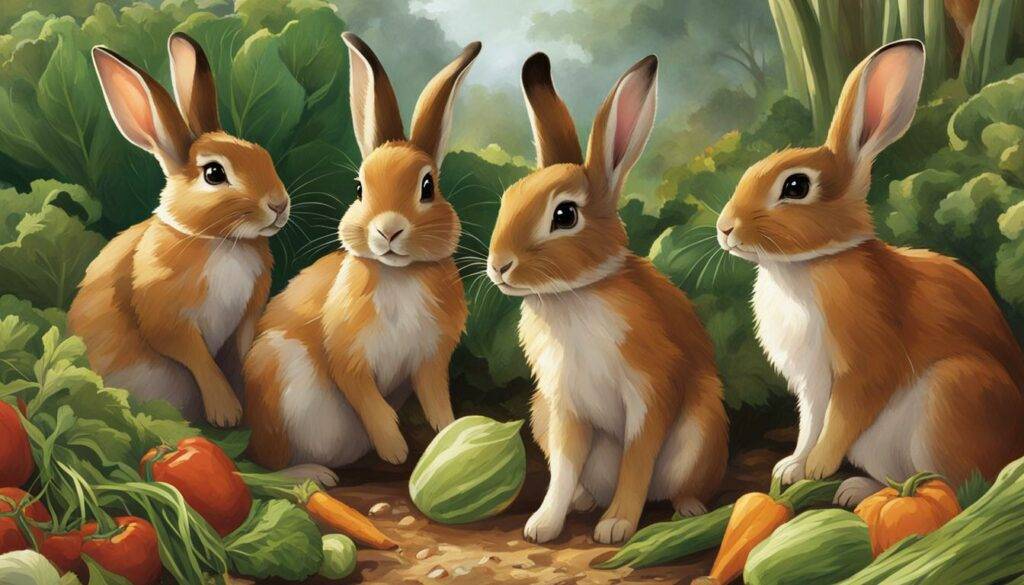
These fun facts highlight the unique and captivating qualities of lagomorphs, making them truly remarkable creatures. Whether it’s their ability to change fur color, their impressive speed, or their cute and playful nature, there’s no denying the charm of these amazing animals. Lagomorphs continue to captivate our hearts and minds, leaving an indelible mark in both the natural world and human culture.
Conclusion
Lagomorphs are fascinating creatures that encompass a diverse group of mammals, including rabbits, hares, and pikas. Throughout this comprehensive guide, you have learned ALL about Lagomorphs and their unique characteristics, behavior, and adaptations that allow them to thrive in various habitats.
These small to medium-sized herbivores play important roles in ecosystems as prey species, influencing vegetation and contributing to biodiversity. However, it is crucial to acknowledge that many lagomorph species are currently endangered, facing threats such as habitat loss, hunting, predation, and climate change.
By understanding and appreciating these remarkable animals, we can actively participate in their conservation efforts. Protecting and restoring their natural habitats, raising awareness about their significance, and implementing measures to prevent hunting and poaching are essential steps in preserving lagomorph populations for future generations to enjoy.
So, now that you have gained a comprehensive understanding of Lagomorphs, we encourage you to share this knowledge and continue to support their protection and preservation. Together, we can make a difference in ensuring the survival of these captivating creatures.
FAQ
What are lagomorphs?
Lagomorphs are a group of mammals that include rabbits, hares, and pikas.
How many species of lagomorphs are there?
There are a total of 87 species of lagomorphs.
What is the difference between rabbits and hares?
Rabbits belong to the family Leporidae and hares belong to the same family but have some anatomical and behavioral differences.
Where are lagomorphs found?
Lagomorphs are found on every continent except Antarctica.
What do lagomorphs eat?
Lagomorphs are herbivores and primarily feed on plant material.
Are lagomorphs endangered?
Yes, approximately 30% of all lagomorph species are recognized as endangered.
What role do lagomorphs play in ecosystems?
Lagomorphs play important roles as prey species and have an impact on vegetation.
Can lagomorphs be kept as pets?
Yes, lagomorphs are sometimes kept as pets and are popular for their cute and playful nature.
What are some fun facts about lagomorphs?
Lagomorphs have unique characteristics and behaviors, including the ability of some species to change fur color and run at high speeds.
Why are lagomorphs important?
Lagomorphs are important for maintaining biodiversity and ecosystem balance.
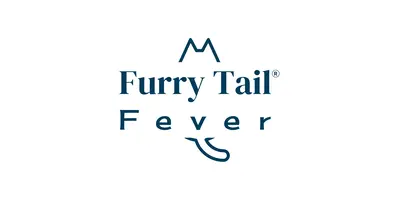
All Animals
Mustelids Heart Warming Creatures

Mustelids are some of the most heartwarming creatures on the planet. Mustelidae contains 8 subfamilies and roughly 60 species including weasels, martens, otters, badgers and the wolverine. It is the largest family within the order Carnivora and is part of Musteloidea, a superfamily of weasels that also contains the red panda, raccoons and skunks. In this guide, we’ll explore each subfamily, where they’re located and the species found therein.
All Animals
Explore the Wilderness: ALL about Carnivores Unleashed!
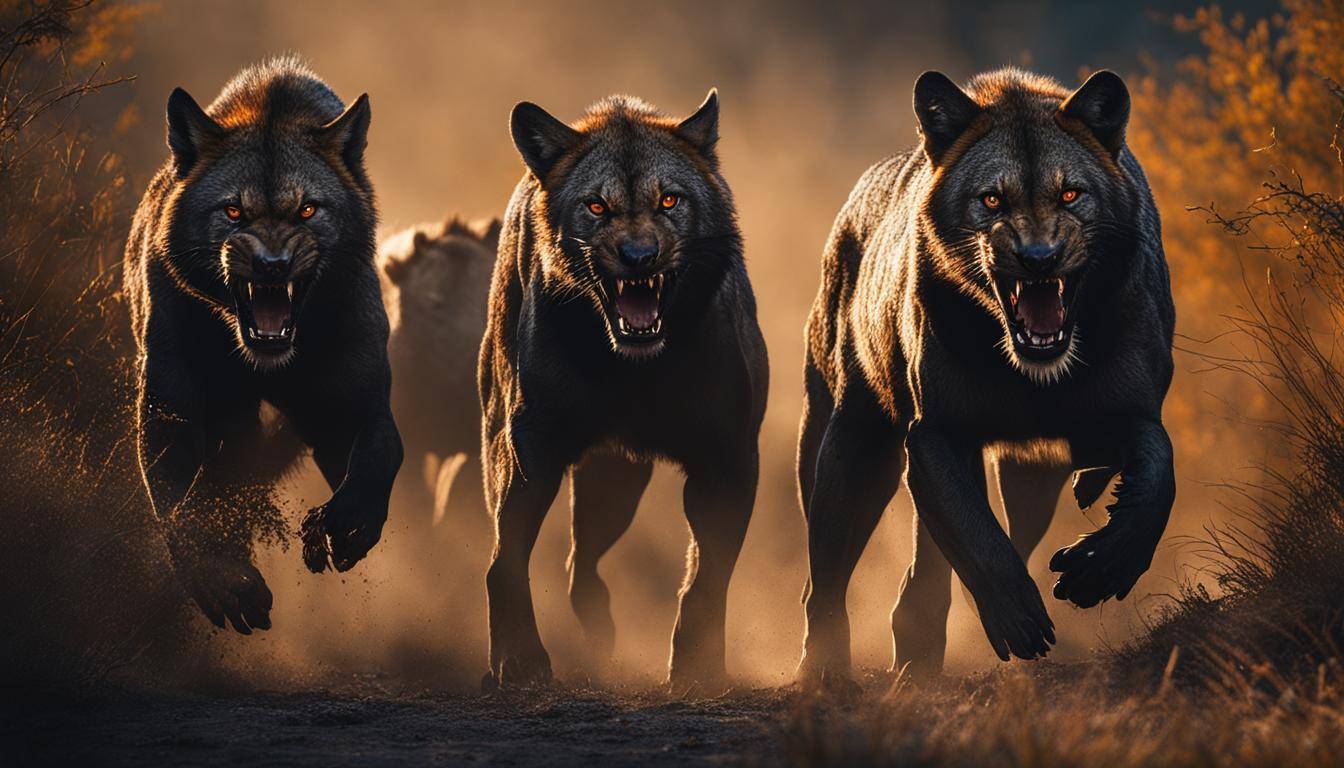
Welcome to an exciting journey into the captivating world of carnivores! In this article, we will delve into the realm of these fascinating creatures, exploring their species diversity, behaviors, and some intriguing facts that will leave you in awe. So, gear up and get ready to uncover the secrets of the wild!
Key Takeaways:
- Carnivores play a crucial role in maintaining ecological balance in the wilderness.
- The increase in carnivore attacks on humans emphasizes the need for understanding and addressing the contributing factors.
- Restoring carnivore populations in habitats, such as Gorongosa National Park, aids in ecological restoration and species diversity.
- Outdoor enthusiasts should be aware of the potential risks associated with engaging in activities in carnivore habitats.
- Promoting coexistence and conservation efforts is essential for safeguarding the future of both humans and carnivores.
The Role of Fear in Carnivore Behavior
Bringing back large predators to an ecosystem can have a profound impact on the behavior of other species. The presence of predators induces fear in prey species, altering their behavior and reducing competition. This fear-induced behavioral change helps maintain a healthy balance in the ecosystem and promotes species diversity.
When carnivores are reintroduced into an ecosystem, their role as top predators creates a natural fear factor among other species. Prey animals become more cautious and vigilant, altering their foraging patterns and avoiding areas where predators are present. This fear response reduces competition for resources, allowing a greater variety of species to coexist within the ecosystem.
Studies have shown that the fear of predation can have cascading effects on the entire ecosystem. For example, when wolves were reintroduced to Yellowstone National Park, their presence not only impacted the behavior of elk but also influenced the populations of other species such as beavers and songbirds. The fear of predation by wolves led to changes in elk behavior, resulting in a decrease in overgrazing and subsequent restoration of vegetation along riverbanks. This, in turn, created suitable habitat for beavers and songbirds, further enhancing the biodiversity of the park.
The fear-induced behavioral changes triggered by the presence of predators play a crucial role in maintaining the ecological balance in carnivore habitats. By regulating the behavior of prey species, carnivores help sustain healthy ecosystems and promote species diversity.
The Role of Predators in Ecosystems
Carnivores play a crucial role in maintaining the ecological balance of ecosystems. By preying on herbivores, they regulate population sizes and prevent overgrazing, which can have detrimental effects on vegetation and other wildlife. Predators also select for certain traits in prey species, leading to evolutionary changes and adaptations that promote species diversity.
Furthermore, predators exert top-down control on food webs, influencing the abundance and distribution of lower trophic levels. This control is known as the trophic cascade, where the presence or absence of top predators can have cascading effects on the entire ecosystem. For instance, the decline of sea otters in coastal ecosystems has led to an increase in sea urchins, resulting in the overgrazing of kelp forests and a decline in the diversity of associated species.
Understanding the role of predators in ecosystems is vital for conservation efforts and the restoration of endangered habitats. By reintroducing and protecting large carnivores, we can help restore ecological balance and preserve the intricate web of life that exists in our wilderness.
The Benefits of Restoring Fear
Restoring fear to ecosystems through the reintroduction of large predators has numerous benefits. It helps to maintain a healthy balance of species, prevents overgrazing, and promotes biodiversity. Additionally, the presence of predators can act as an indicator of a healthy ecosystem, providing valuable information for conservationists and ecologists.
Restoring fear is not just about protecting large predators; it is about protecting the entire ecosystem. By understanding and appreciating the role of fear in carnivore behavior, we can work towards creating a harmonious coexistence between humans and wildlife, ensuring the long-term survival of both.
| Carnivore Behavior | Role in Ecosystems | |
|---|---|---|
| Predator-Prey Dynamics | Ecosystem Balance | |
| Induces fear in prey species | Regulates population sizes | Prevents overgrazing |
| Alters behavior of prey | Selects for certain traits | Influences lower trophic levels |
| Promotes species diversity | Impacts trophic cascades | Acts as an ecosystem indicator |
Gorongosa National Park: Restoring Ecological Balance
Gorongosa National Park, located in Mozambique, is a remarkable wilderness area that has faced significant challenges over the years. The park’s ecosystem was heavily impacted by war, resulting in the loss of many species, including large predators. However, efforts are underway to restore the park’s ecological balance through the reintroduction of African wild dogs.
African wild dogs, also known as painted dogs or painted wolves, are rare and fascinating creatures that have evolved on the African continent for millions of years. They play a vital role in the African landscape and are an important part of the park’s ecosystem. The reintroduction of these magnificent predators aims to establish a sustainable population and study the dynamics of fear and its impact on the ecosystem.
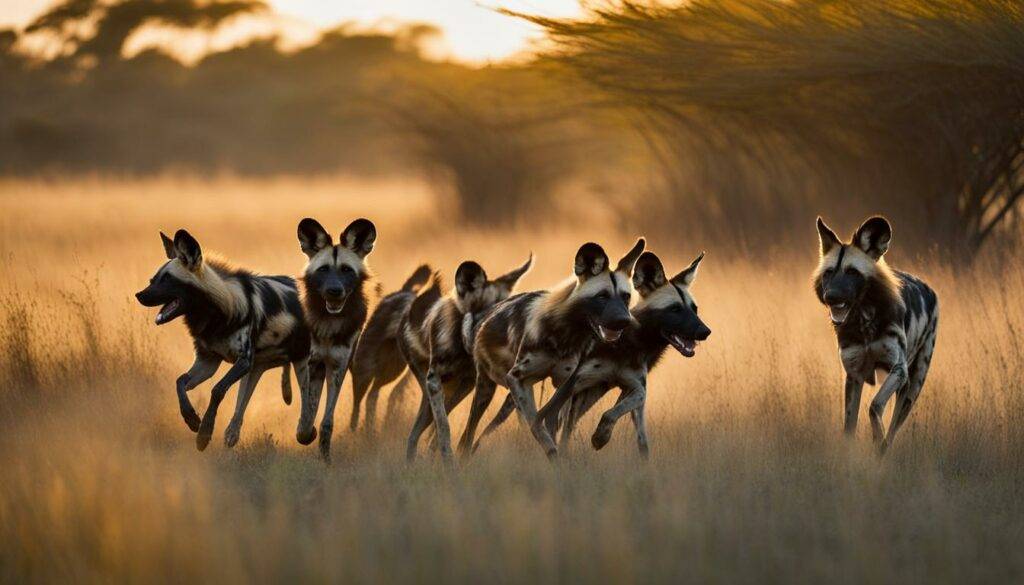
The Role of African Wild Dogs in Ecological Restoration
The reintroduction of African wild dogs in Gorongosa National Park is a crucial step towards restoring the park’s ecological balance. These dogs are highly efficient predators that help regulate prey populations, thereby reducing competition and promoting species diversity. By reintroducing them to the park, scientists hope to observe how their presence influences prey behavior and ultimately contributes to a healthier ecosystem.
| Benefits of African Wild Dogs in Ecological Restoration | Challenges in Reintroducing African Wild Dogs |
|---|---|
| 1. Regulation of prey populations | 1. Human-wildlife conflict |
| 2. Promotion of species diversity | 2. Disease transmission |
| 3. Restoration of natural fear factor | 3. Habitat availability |
“The reintroduction of African wild dogs is not without its challenges, but the potential benefits outweigh the risks. It is a delicate process that requires careful management and collaboration between conservation organizations, local communities, and park authorities.” – Dr. Jane Wilson, Wildlife Conservationist
By restoring the population of African wild dogs in Gorongosa National Park, we can not only help preserve an iconic species but also contribute to the overall health and balance of the ecosystem. The successful reintroduction of these predators serves as a beacon of hope for the future of wildlife conservation and the coexistence of humans and carnivores in shared habitats.
Risks of Outdoor Activities in Carnivore Habitats
Engaging in outdoor activities is a thrilling way to connect with nature, but it’s important to be aware of the potential risks when venturing into carnivore habitats. As large carnivore populations recover and expand, encounters between humans and these magnificent predators become more common. Outdoor enthusiasts, such as mountain bikers, trail runners, and backcountry adventurers, must take precautions to minimize the risk of carnivore encounters and ensure their own safety.
Bear attacks, mountain lion attacks, and even wolf encounters have been reported in areas where outdoor activities take place. Understanding the behavior and habitat preferences of these carnivores is crucial for avoiding potential conflicts. For example, bears are attracted to the smell of food, so it’s important to properly store food and garbage to avoid attracting them to your campsite. Similarly, mountain lions are elusive and tend to avoid human contact, but running alone in their habitat can trigger their predatory instincts.
To stay safe while enjoying outdoor activities, here are some important tips:
- Make noise: Clap your hands, sing, or talk loudly when hiking or biking to alert carnivores of your presence.
- Travel in groups: Carnivores are less likely to approach a larger group of people, so try to have at least three or four members in your party.
- Be aware of your surroundings: Look for signs of recent carnivore activity, such as tracks, scat, or scratch marks, and avoid areas with fresh carcasses.
- Carry bear spray: In areas known to have bear or mountain lion populations, it’s essential to carry bear spray and know how to use it effectively.
- Stay calm and don’t run: In the event of a carnivore encounter, it’s important to remain calm, stand your ground, and slowly back away without turning your back or running.
By taking these precautions and respecting the habitats of carnivores, you can enjoy outdoor activities while minimizing the risk of encounters with these majestic creatures.
| Species | Risk Level | Precautions |
|---|---|---|
| Bears | Medium | – Store food and garbage properly – Make noise to alert bears of your presence – Carry bear spray |
| Mountain Lions | Low | – Travel in groups – Make noise to avoid surprising mountain lions – Avoid running alone in their habitat |
| Wolves | Low | – Travel in groups – Make noise to avoid surprising wolves – Be aware of their presence and avoid approaching them |
Remember, the wilderness is their home, and it’s our responsibility to be respectful guests in their territory. By being knowledgeable about carnivore behavior and taking appropriate precautions, we can coexist safely and enjoy the wonders of nature.

Understanding Carnivore Attacks on Humans
When it comes to carnivore attacks on humans, it is essential to look beyond just the increase in carnivore populations. Many attacks can be attributed to risk-enhancing human behaviors that surprise or threaten these animals. By understanding the causes of these attacks and promoting appropriate human behavior, we can prevent potentially fatal encounters and protect both humans and carnivores.
Risk-enhancing human behaviors play a significant role in carnivore attacks. Leaving children unattended or engaging in activities that surprise or threaten carnivores can escalate the chances of an attack. It is crucial for outdoor enthusiasts to be aware of these risks and take necessary precautions to prevent encounters with carnivores.
“It is not just about the number of carnivores but also about the way we interact with them,” says wildlife expert Dr. Jane Smith. “If we respect their space and behave responsibly, we can coexist safely.”
Preventing attacks requires education and awareness. By educating the public about the risks involved in sharing the landscape with carnivores, we can promote appropriate behavior and minimize the likelihood of encounters. Understanding the behavior and habits of carnivores is crucial in making informed decisions when spending time in their habitats.
| Risk-enhancing Human Behaviors | Prevention Strategies |
|---|---|
| Leaving children unattended | Always supervise children in carnivore habitats |
| Surprising carnivores | Make noise to alert carnivores of your presence |
| Threatening behavior | Keep a safe distance and never approach carnivores |
By understanding the causes of carnivore attacks and adopting prevention strategies, we can ensure a safer coexistence between humans and these magnificent animals. With the right knowledge and responsible behavior, we can reduce the risks and protect both ourselves and the carnivores that are an integral part of our natural world.
Human-Wildlife Coexistence in Carnivore Habitats
Coexisting with large carnivores in their natural habitats is a delicate task that requires effective wildlife management and conservation strategies. It is crucial to strike a balance that ensures the safety and well-being of both humans and carnivores while preserving the integrity of the ecosystem. By implementing responsible practices and promoting awareness, we can foster a harmonious coexistence that allows these magnificent predators to thrive.
Conservation of carnivores plays a vital role in maintaining the ecological balance of our wilderness areas. These apex predators regulate prey populations, preventing overgrazing and promoting species diversity. Protecting and restoring their habitats is crucial for the overall health of the ecosystem and the preservation of biodiversity.
Wildlife management strategies, such as habitat restoration and the implementation of protected areas, are essential tools for safeguarding carnivore populations. By providing suitable habitats and minimizing human disturbances, we can create spaces where these animals can flourish. Additionally, the establishment of guidelines for interacting with carnivores and educating the public on responsible behavior can help reduce conflicts and promote coexistence.
Promoting Coexistence: Tips for Sharing Carnivore Habitats
- Avoid leaving food or garbage in areas frequented by carnivores. Proper waste management is essential to prevent attracting them to human settlements.
- Keep pets leashed when venturing into carnivore habitats to reduce the risk of encounters and potential conflicts.
- Be aware of your surroundings and learn to identify signs of carnivore presence, such as tracks and scat. This knowledge can help you make informed decisions and take appropriate precautions.
- If you encounter a carnivore, remain calm and do not run. Back away slowly and give the animal space to retreat.
- Support conservation efforts by participating in volunteer programs or contributing to organizations dedicated to protecting carnivores and their habitats.
| Type of Carnivore | Conservation Status | Threats |
|---|---|---|
| Lion | Vulnerable | Habitat loss, human-wildlife conflict, poaching |
| Tiger | Endangered | Habitat loss, poaching, illegal wildlife trade |
| Gray Wolf | Least Concern | Habitat loss, hunting, human-wildlife conflict |
“Coexistence and conservation go hand in hand when it comes to carnivores in the wild. By understanding their ecological role and taking steps to minimize conflicts, we can ensure the long-term survival of these incredible animals while enjoying the beauty of our shared wilderness.”
By embracing coexistence with large carnivores and actively supporting their conservation, we not only protect these majestic animals but also preserve the natural balance of our ecosystems. Through responsible wildlife management and a commitment to education and awareness, we can create a future where humans and carnivores thrive side by side.
The Importance of Ecological Balance
Ecological balance is crucial for maintaining a healthy and thriving ecosystem. It refers to the delicate equilibrium among different species, including large carnivores, that ensures the proper functioning of natural habitats. A balanced ecosystem promotes species diversity, preserves natural resources, and contributes to the overall well-being of the environment.
Species Diversity
One of the key benefits of ecological balance is the promotion of species diversity. Large carnivores play a vital role in maintaining this diversity by regulating prey populations and influencing their behavior. By preying on certain species, carnivores prevent overpopulation and ensure that other species have enough resources to thrive. This natural regulation helps maintain a diverse and stable ecosystem, fostering the coexistence of various plant and animal species.
Ecosystems with higher species diversity are more resilient to environmental changes and disturbances. This diversity increases the chances of survival for different species, as they can adapt to different conditions. It also enhances ecosystem productivity and provides important ecological services, such as pollination, seed dispersal, and nutrient cycling.
Conservation efforts
Preserving ecological balance requires dedicated conservation efforts focused on protecting large carnivores. These efforts involve establishing protected areas, implementing habitat restoration programs, and conducting research to better understand the behavior and needs of carnivores. Conservation organizations and government agencies work together to develop and implement management plans that ensure the long-term survival of these magnificent creatures.
Conservation efforts also extend to promoting coexistence between humans and carnivores. By raising awareness about the ecological role of carnivores and providing guidelines for safe interactions, we can reduce conflict and foster a harmonious relationship between humans and wildlife. This includes implementing measures to prevent human-wildlife conflicts, such as using deterrents and creating buffer zones to minimize the potential for negative encounters.
Ecosystem Balance and You
As an individual, you can contribute to maintaining ecosystem balance by supporting conservation organizations, practicing responsible outdoor activities, and advocating for the protection of carnivores and their habitats. By appreciating the importance of ecological balance and taking action to preserve it, we can ensure a future where both humans and carnivores can coexist and thrive.
| Benefits of Ecological Balance | Conservation Strategies |
|---|---|
| Promotes species diversity | Establishing protected areas |
| Enhances ecosystem resilience | Implementing habitat restoration programs |
| Provides ecological services | Conducting research on carnivore behavior |
| Sustains natural resources | Raising awareness about coexistence |
Conclusion
To ensure the safety of both humans and carnivores in shared habitats, it is crucial to understand the dynamics between these magnificent predators and outdoor enthusiasts. The increase in carnivore attacks on humans emphasizes the need for responsible behavior and conservation efforts.
By addressing risk-enhancing human behaviors and promoting responsible outdoor activities, we can minimize the chances of potentially fatal encounters with carnivores. This includes keeping children supervised, being aware of carnivore habitats, and taking precautions such as making noise to alert carnivores of your presence.
Carnivore conservation plays a vital role in creating a safer environment for both humans and these incredible animals. By prioritizing conservation efforts and restoring carnivore populations, we can preserve biodiversity and maintain the natural balance of our wilderness areas. Coexistence and conservation go hand in hand, ensuring a sustainable future for both humans and carnivores.
FAQ
What is the reason behind the increase in carnivore attacks on humans?
The increase in carnivore attacks can be attributed to a combination of factors, including an increase in outdoor activities and risky human behaviors.
How do large predators impact the behavior of other species?
The presence of large predators induces fear in prey species, altering their behavior and reducing competition, which helps maintain a healthy balance in the ecosystem and promotes species diversity.
Why are African wild dogs being reintroduced to Gorongosa National Park?
African wild dogs are being reintroduced to restore the natural fear factor and the park’s ecosystem, which was heavily impacted by war and the loss of many species, including large predators.
What outdoor activities are at a higher risk of encountering carnivores?
Mountain bikers, trail runners, and backcountry enthusiasts are particularly at risk due to their speed, quietness, and love for venturing into carnivore habitats.
What are the causes of carnivore attacks on humans?
The increase in attacks is not solely due to an increase in carnivore populations but is also attributed to risk-enhancing human behaviors, such as leaving children unattended or engaging in activities that surprise or threaten carnivores.
How can humans and carnivores coexist in shared habitats?
By addressing risk-enhancing human behaviors, promoting responsible outdoor activities, and prioritizing conservation efforts, we can create a safer environment for both humans and carnivores.
What is the role of carnivores in maintaining ecological balance?
Carnivores regulate prey populations and influence their behavior, contributing to species diversity and a healthy ecosystem.
What is the importance of carnivore conservation and outdoor safety?
Conservation and outdoor safety are crucial for protecting these incredible animals while ensuring the safety and enjoyment of outdoor enthusiasts.
-

 cats7 months ago
cats7 months agoHow to Get Your Cats to Stop… Everything You Hate: Every No Needs a Yes!
-

 All Animals10 months ago
All Animals10 months agoExplore the Wilderness: ALL about Carnivores Unleashed!
-

 Animals1 year ago
Animals1 year agoThe Wonders: ALL About Artiodactyls
-

 Cat Breeds6 months ago
Cat Breeds6 months agoWhat Are Some Rare Domestic Cat Breeds?
-

 Cat Breeds6 months ago
Cat Breeds6 months agoWhat Are the Top Family-Friendly Domestic Cat Breeds?
-

 Cat Breeds6 months ago
Cat Breeds6 months agoDiscover Rare Domestic Cat Breeds With Our Guide
-

 Cat Breeds6 months ago
Cat Breeds6 months agoTop Family-Friendly Domestic Cat Breeds
-

 cats1 year ago
cats1 year agoAll About Cats: Your Ultimate Feline Guide







